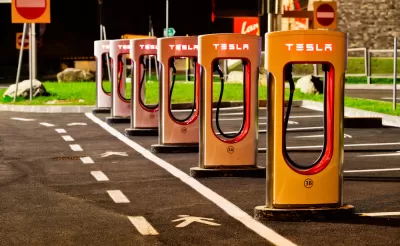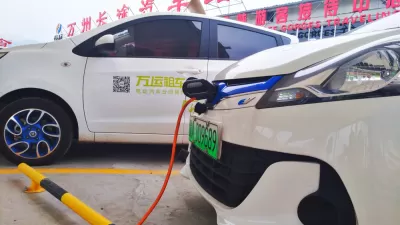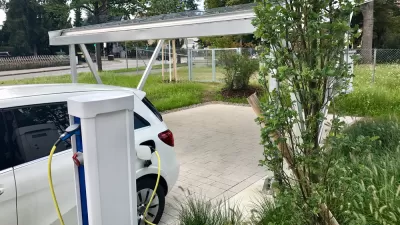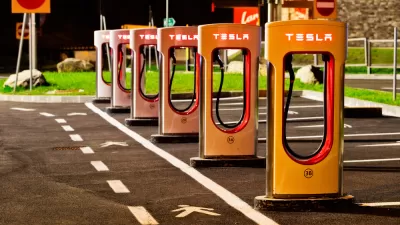U.S. sales of plug-in electric vehicles, including those with internal combustion engines, increased by 81 percent in 2018 over 2017. But if you remove the best-selling Tesla Model 3 from the mix, the increase drops to 11 percent.

"The 2018 numbers are in, and total U.S. EV sales came in at 361,307 for the year — up 81 percent over 2017 — according to the tracking website Inside EVs," reports Julia Pyper for Greentech Media (GTM) on Jan. 7. The number is expected to be less than 2 percent of total auto sales, but higher than one percent, where it has hovered for the prior two years.
Last year’s strong sales performance really came down to one thing: Tesla. The Silicon Valley automaker sold 139,782 units of the Model 3 in 2018, according to Inside EVs. Including the Model S and the Model X, Tesla was responsible for more than 50 percent of total plug-in vehicle sales last year.
Taking the Model 3 out of the mix, U.S. EV sales increased by only 11 percent last year, a poor showing by most standards.
Pyper talks with analysts who feel optimistic that other manufacturers will offer new models that are competitive with Tesla, which is important as some analysts forecast Tesla's sales to decline
“I don’t think 2019 is going to be all about the Model 3," said Chris Nelder, manager of Rocky Mountain Institute’s mobility practice. "There are a lot more manufacturers making a lot more EVs.”
There are several new mass-market EVs available with over 200 miles of electric range, such as the Kia Soul and Kia Niro. At the same time, brands such as Mercedes, BMW, Porsche, Jaguar and Audi are launching headline-grabbing high-performance electric cars — and putting real pressure on Tesla for the first time.
However, judging by the few electric vehicle models on display at the North American International Auto Show in Detroit on Sunday, and the great number of gas-powered SUVs, Associated Press auto writer Tom Krisher sees little reason to think that 2019 will be the year of the electric vehicle.
In addition, with General Motors' announcement last November that it will closing many of its car manufacturing plants and shift production toward their better-selling light truck lineup, the sixth best-selling EV in the U.S., the Chevy Volt, will cease production. The Chevy Bolt was #7 last year, according to Inside EVs.
Federal EV credit decreases
While the Trump administration has threatened to eliminate federal tax credits for all-electric and plug-in hybrid vehicles, as much as $7,500 per vehicle, and Senator John Barrasso, a Republican from Wyoming, introduced a bill on Oct. 6, 2018 to end the program and tax them instead, the credits will phase-out by design when manufacturers sell 200,000 plug-in models, as Tesla did last summer and General Motors last month.
As the federal subsidy decreases, what will be the impact on EV sales?
AP's Krisher reported earlier that Tesla dropped the price on its models by $2,000, in part because the federal credit dropped by 50 percent to $3,750 on Jan. 1, and will gradually end this year. The other reason: demand appears to be decreasing.
"They have for a long time had more demand than supply," said Michael Ramsey, research director at analysis firm Gartner. "It's becoming apparent that that dynamic is changing."
EV sales underperform in U.S.
Even with the spectacular sales of the Model 3, making it the best-selling luxury car and the fifth best-selling car in the U.S. last year, EV sales in the U.S. lag behind other nations.
"U.S. EV sales to date have been underwhelming," adds GTM's Pyper.
While launching an entirely new class of vehicles is no easy feat, China has seen adoption levels surge, while European countries lead on a per-capita basis.
The U.S. EV sector has seen incremental growth over the past several years, but it has yet to reach an inflection point. And sales actually saw a dip in 2015.
Future California sales
According to a new report from the Institute of Transportation Studies at the University of California at Davis, an upcoming zero-emissions fee could have a chilling effect on EV sales. The $100 annual "road improvement fee" in the Road Repair and Accountability Act of 2017 won't take effect until January 2020, but researcher Alan Jenn indicates it could damper sales by as much as 20 percent.
The report to the California legislature recommends the flat, annual fee be replaced with an vehicle-miles traveled fee applicable only to zero-emission vehicles.
Related in Planetizen:
- Electric Vehicle Incentives: A Tale of Two Countries: U.S. & Norway, December 30, 2018
Hat tip to Ed Mainland.
FULL STORY: US Electric Vehicle Sales Increased by 81% in 2018

Study: Maui’s Plan to Convert Vacation Rentals to Long-Term Housing Could Cause Nearly $1 Billion Economic Loss
The plan would reduce visitor accommodation by 25,% resulting in 1,900 jobs lost.

Alabama: Trump Terminates Settlements for Black Communities Harmed By Raw Sewage
Trump deemed the landmark civil rights agreement “illegal DEI and environmental justice policy.”

Why Should We Subsidize Public Transportation?
Many public transit agencies face financial stress due to rising costs, declining fare revenue, and declining subsidies. Transit advocates must provide a strong business case for increasing public transit funding.

Paris Bike Boom Leads to Steep Drop in Air Pollution
The French city’s air quality has improved dramatically in the past 20 years, coinciding with a growth in cycling.

Why Housing Costs More to Build in California Than in Texas
Hard costs like labor and materials combined with ‘soft’ costs such as permitting make building in the San Francisco Bay Area almost three times as costly as in Texas cities.

San Diego County Sees a Rise in Urban Coyotes
San Diego County experiences a rise in urban coyotes, as sightings become prevalent throughout its urban neighbourhoods and surrounding areas.
Urban Design for Planners 1: Software Tools
This six-course series explores essential urban design concepts using open source software and equips planners with the tools they need to participate fully in the urban design process.
Planning for Universal Design
Learn the tools for implementing Universal Design in planning regulations.
Smith Gee Studio
Alamo Area Metropolitan Planning Organization
City of Santa Clarita
Institute for Housing and Urban Development Studies (IHS)
City of Grandview
Harvard GSD Executive Education
Toledo-Lucas County Plan Commissions
Salt Lake City
NYU Wagner Graduate School of Public Service





























